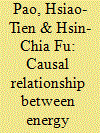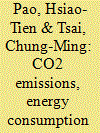|
|
|
Sort Order |
|
|
|
Items / Page
|
|
|
|
|
|
|
| Srl | Item |
| 1 |
ID:
125580


|
|
|
|
|
| Publication |
2013.
|
| Summary/Abstract |
This study investigates the causal relationship between clean and non-clean energy consumption and economic growth in Brazil over the period of 1980-2009. Clean energy consumption at aggregated level of total renewable energy consumption and disaggregated levels of hydroelectric, new renewables, and nuclear energy consumption are tested within a production function framework. A cointegration test reveals a long-term equilibrium relationship between real output, capital, labor, and renewable and non-renewable energy consumption at aggregated level, and a long-term equilibrium relationship between real output, capital, labor, and hydroelectric/new renewables/nuclear and fossil fuel energy consumption at disaggregated level. The capital, labor, and new renewables elasticities of real output are positive and statistically significant, other energy consumption item's elasticities are insignificant. The results from error correction model reveal the interdependencies between new renewables, nuclear, fossil fuel, and total non-renewable energy consumption and economic growth, the unidirectional causality from hydroelectric/total renewable consumption to economic growth, the substitutability between new renewables and fossil fuel consumption, and the substitutability between new renewables and nuclear energy consumption. Additionally, nuclear and new renewables energy consumption responds to bring the system back to equilibrium. Overall, aggregated analysis may obscure the relationship between different types of clean energy consumption and economic growth.
|
|
|
|
|
|
|
|
|
|
|
|
|
|
|
|
| 2 |
ID:
128457


|
|
|
|
|
| Publication |
2014.
|
| Summary/Abstract |
This paper explores the causal relationship between clean (renewable/nuclear) and non-clean energy consumption and economic growth in emerging economies of the MIST (Mexico, Indonesia, South Korea, and Turkey) countries. The panel co-integration tests reveal that there is a long-term equilibrium relationship among GDP, capital formation, labor force, renewable/nuclear, and fossil fuel energy consumption. The panel causality results indicate that (1) there is a positive unidirectional short-run causality from fossil fuel energy consumption to economic growth with a bidirectional long-run causality; (2) there is a unidirectional long-run causality from renewable energy consumption to economic growth with positive bidirectional short-run causality, and a long-run causality from renewable to fossil fuel energy consumption with negative short-run feedback effects; and (3) there is a bidirectional long-run causality between nuclear energy consumption and economic growth and a long-run causality from fossil fuel energy consumption to nuclear energy consumption with positive short-run feedback effects. These suggest that MIST countries should be energy-dependent economies and that energy conservation policies may depress their economic development. However, developing renewable and nuclear energy is a viable solution for addressing energy security and climate change issues, and creating clean and fossil fuel energy partnerships could enhance a sustainable energy economy.
|
|
|
|
|
|
|
|
|
|
|
|
|
|
|
|
| 3 |
ID:
101505


|
|
|
|
|
| Publication |
2010.
|
| Summary/Abstract |
This paper examines dynamic causal relationships between pollutant emissions, energy consumption and output for a panel of BRIC countries over the period 1971-2005, except for Russia (1990-2005). In long-run equilibrium energy consumption has a positive and statistically significant impact on emissions, while real output exhibits the inverted U-shape pattern associated with the Environmental Kuznets Curve (EKC) hypothesis with the threshold income of 5.393 (in logarithms). In the short term, changes in emissions are driven mostly by the error correction term and short term energy consumption shocks, as opposed to short term output shocks for each country. Short-term deviations from the long term equilibrium take from 0.770 years (Russia) to 5.848 years (Brazil) to correct. The panel causality results indicate there are energy consumption-emissions bidirectional strong causality and energy consumption-output bidirectional long-run causality, along with unidirectional both strong and short-run causalities from emissions and energy consumption, respectively, to output. Overall, in order to reduce emissions and not to adversely affect economic growth, increasing both energy supply investment and energy efficiency, and stepping up energy conservation policies to reduce unnecessary wastage of energy can be initiated for energy-dependent BRIC countries.
|
|
|
|
|
|
|
|
|
|
|
|
|
|
|
|
|
|
|
|
|